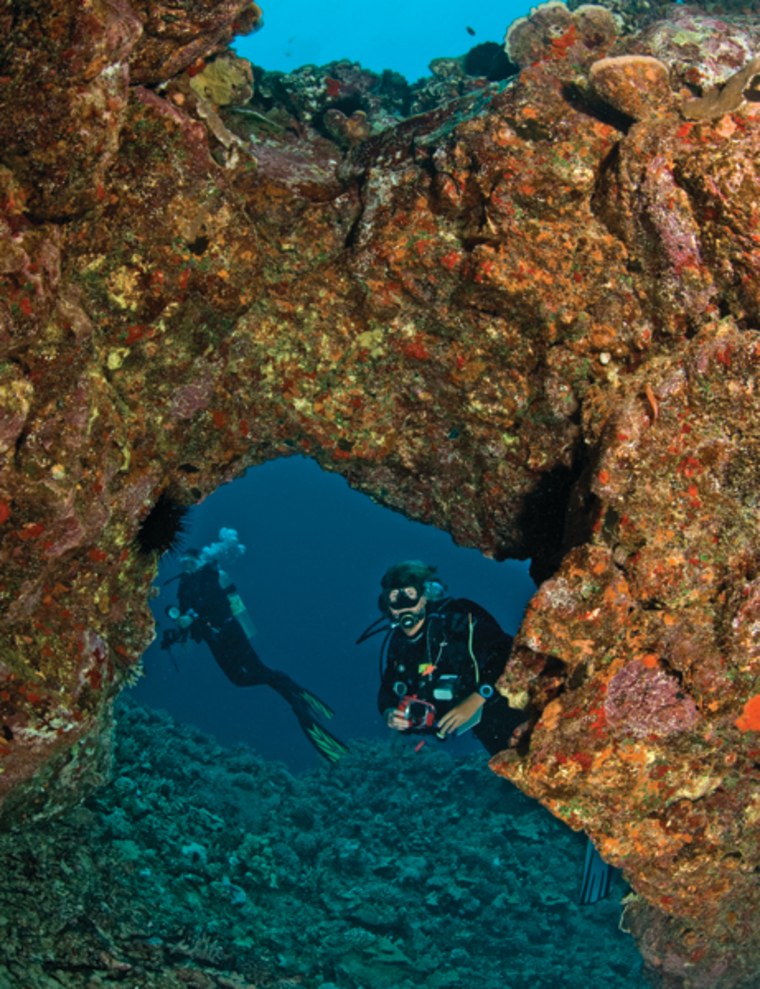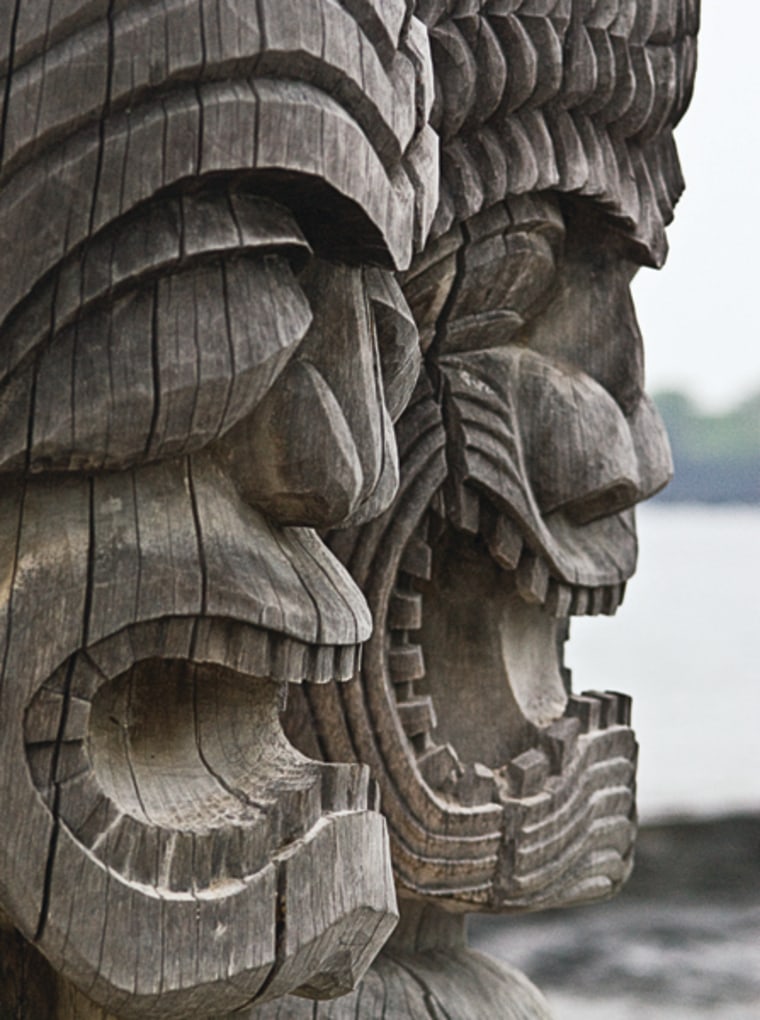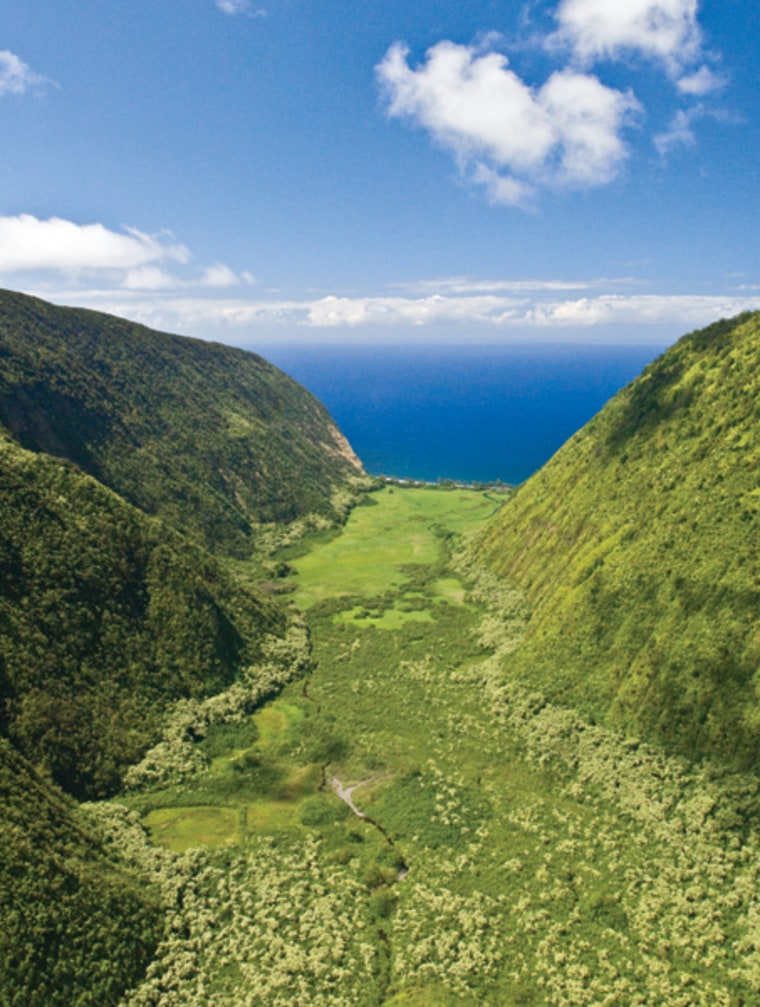Myths and fables, stories of the sea and a parade of legends, gods, demigods, goddesses, spirits and other mythical beings, places and tales are what define Kona. That dense, cultural texture reflects the wild complexity of this, the youngest of the Hawaiian Islands. People use legends to understand their world. And when you live on an active volcano, understanding is absolutely essential.
All things come from the sea
Only 13 climatic zones exist in the entire world, and 11 of them can be found on the Big Island of Hawaii, simply called Kona. The island began its life eons ago at the bottom of the sea, where only marine creatures witnessed its slow emergence. Now cloaked in snow for much of the year, at one time the Mauna Kea volcano came struggling to the surface as lava pushed upward. The only possible air-breathing witness to the event would have been a passing honu (green turtle). Ancient and intrinsically tied to Kona, these honu roamed the seas when Kona first rose above the waves in a fit of volcanic ferocity.
The reefscape left by this volcanic whimsy is twisted, arched and full of caverns, pinnacles and lava tubes. Hard corals have transformed the shapes into islands of life. And in the isolation, the marine animals evolved uniquely, with some 25 percent of everything you’ll see known only in these waters.
To see as much as possible of the volcanic bones that make up the reefscape off the Big Island, my buddy and I head to the PADI Dive Resort Kona Village Resort in the heart of the Kohala Coast, and look up Jimmy Kilbride. Jimmy knows the area intimately, so when he tells us we’re venturing out by Diver Propulsion Vehicle, we know we’ll have a book’s worth of experiences.
We don’t dive just one site; we dive undersea swaths by this method. At the first site, Kua Bay, we jump in, settle on the black-sand seafloor, put the scooters between our legs and off we go. Jimmy knows there are as many small critters as big ones that we should see off Kohala, so we buzz around the volcanic substrate, under arches, stopping at swim-throughs and caverns with sleeping whitetip reef sharks. We circle around coral heads and stop to visit several of Jimmy’s favorite critters — eels surrounded by sweepers, large frogfish and reef octopi. We glide over acres of pristine hard corals presided over by clouds of surgeonfish, snapper, raccoon butterflyfish and squirrelfish.
As we buzz along the reef, we come across several green sea turtles, and flying in formation with them on the scooters makes the encounters last longer than normal. When several spotted eagle rays pass, we spin, twirl and cross over big chunks of the reef to follow them. They hardly look as if they’re trying, while our scooters strain to keep up. Then, with a slight flip of their fin tips, they vanish into the underwater mist.
Back at Kona Village Resort, we settle into our traditionally built hale or house. Each evening, honu come here to Kahuwai Bay to pull themselves ashore and rest on the crescent of black sand beach. The Kona Village was built on the site of an ancient Hawaiian fishing village, and on the premises you can see more than 400 petroglyphs. The entire Kohala Coast is built as much on legends and sacred sites as it is on lava rocks.

There’s a warm power here, one that deepens further into my bones with each visit. It’s like the land, the lava, the ocean and the hidden spirits have let me into their world. It’s this transformation and the tranquility of the resort that bring people back year after year. You’ll be caressed by oceanic breezes born thousands of miles away and be lulled into reflection by the waves. This trip, I do something that I haven’t done in quite a while. I settle into a chair on the shore and read a book in the sun.
That night, after the Kona Village Luau, I watch as manta rays somersault beneath Jimmy’s dive boat, which he’s rigged with lights aimed toward the water. I could snorkel out to join them, but this is their revelry. So I’m content to just sit on the sand beneath a darkened sky and wonder what secret lives are being played out in the lightless blue realm lapping at my feet.
The favored place
After the Kohala Coast, we make our way to Kailua-Kona and the Keauhou Beach Resort. The resort has one of the largest heiau, or ancient temples, on the island, built for King Kalakaua. And its adjacent Kahalu’u Bay fills with green sea turtles each evening. Kailua-Kona was the favored place for kings to live in ancient times because of its weather and plentitude of fresh water. So, when you walk the grounds, you walk the paths of kings. You’ll be lulled by the same aroma of the plumeria and shaded by the same kinds of trees — kukui and palm.
The Keauhou Beach Resort is also the only dive-centric resort on the island, so it’s not only for royalty — it’s for explorers as well. There’s an on-site PADI Five-Star IDC, Bottom Time Hawaii, which frequently ventures to the more-remote southern sites, such as Au Au Crater, Driftwood, Long Lava Tube and Amphitheater. I’m here because of the legendary diving, and I make a yearly pilgrimage to these waters.
But first, to begin to comprehend the complexity of Kona, you’ll need to take to the air, which Jeff Kirschner at Bottom Time Hawaii arranges for me.
From the moment we lift off by helicopter, the island takes on a different pulse. We fly over miles of desolate fields of black lava along the Kohala Coast — a harsh, dry landscape where only the heartiest of grasses find purchase. Here, dark lava meets the sea and gets wrapped in blue. At the edges, along black sand beaches, there’s a green line of hardy palm trees. In the water, as we navigate up the coast, we see honu, mantas, dolphins and mano (sharks) — all visible from our lofty perch, all moving among the submerged volcanic reefs, arches, caverns and lava tubes.
We turn south toward the town of Kailua-Kona. From above, a gathering mist shows us which way the wind blows, where the demigod of the rain clouds, Kuula, resides. The upper slopes turn a vivid, almost impossible green with the moisture, and clouds wrap like a silken cloak over the hills. This landscape you taste — the volcanic soil nurtures Kona coffee.
Above the cloud forest, the land continues upward to 13,796 feet, where the snow goddess Poliahu drapes the peak of Mauna Kea in white. We follow the coastline, though, past the Place of Refuge, a sacred bay that promised life and a fresh start to ancient Hawaiian lawbreakers. Over the sea-turtle haven and freshwater springs of Punalu’u — which means “diving spring” — there is a black sand beach where the goddess Kauila watches over children playing in the water. The sea looks calm, like blue glass. But when we arrive at Volcanoes National Park, the island is visibly alive, heaving and gasping with life.
Lava pours into the sea, and a thrilling white column of gas climbs skyward from the point where the two meet. The trade winds grab the plume and drag it down the coastline. By the time it reaches Kailua-Kona, where we’ve just come from, it will have spread from summit to sea in a hazy “vog,” or volcanic fog, that settles over the land when the house of Pele rumbles.
From above, the goddess Pele’s plume of acidic gas looks almost delicate, belying the raw, primal violence at the spot where molten rock and the Pacific clash. Here on Kona, the earth constantly reminds us that the land lives, breathes and evolves. As we watch, inch by inch the Big Island grows bigger still, with every brawl of hissing, popping and exploding sea-wetted lava.
We turn inland and follow the river of lava. It flows just under the cooled lava at the surface. Like stepping stones leading to the Kilauea Volcano, vents of steam fire out of fissures, gashes and clefts in the rock that lead straight to the caldera. Every now and then, through a gap, we can see the flow — bright orange, full of menace — like a mesmerizing peek into a beautiful nightmare. Its movement seems considered … and entirely unstoppable.
Even from several hundred feet above the flow, I sense fear. It’s one thing to see a river of lava in photos, but the live experience will drill its way into your core.
We pause above the smoking caldera of Kilauea. We’re lucky that the island has chosen today to rumble to life. We watch the vapor swirl, thick and heavy with airborne bits of the Earth’s core, its pulse. Few places on the planet are so palpably alive.
At moments like this, it’s almost impossible to believe that only a few miles away my hotel room overlooks a peaceful bay where green sea turtles come to sun and rest.
But as powerful an impact as Pele has had on Kona, she pales next to the puissance of time and tide, and the supremacy of the tiniest elements of nature to transform the land and the reef.
When we reach the wonder of the Waipio Valley, we have passed through epochs of evolution and now hover above a Polynesian Eden, once the exclusive realm of chiefs.
Their sacred temples still exist in the valley, green and lush, and swelling with waterfalls, rainforests (Continued on page 90) (Kona continued from page 72) and a landscape eroded to only the most picturesque designs is the true temple. Yet the sea here seems jealous of the land — it’s restless and unquiet and unleashes large swells. The king of all sharks, Kamohoalii, once prowled the sea at the foot of the valley. There’s even a downed World War II bomber wedged into a small crevice, so difficult to reach that almost no one has seen it, except from the air.
Returning to sea level, we don’t travel far from Honokohau Harbor for our first dives with Bottom Time Hawaii. In fact, just outside the harbor, we moor up at Green Buoy. A gathering place, the buoy attracts the big stars like a beacon. I’ve just turned my eyes away from a spotted-eagle-ray cleaning station on the sand bottom at about 90 feet because my camera housing, which is all electronic, decides that now is a good time to turn itself off. When I finally get everything running, I feel a presence — a big presence. I look up to see a huge tiger shark barreling down on me.
Now, I don’t care who you are; 15 feet of apex predator accelerating purposely toward you will do wonders to freshen your heart rate. I lift the camera and fire off a shot — it’s more of a hopeful warning shot across the bow than a well-considered image-making effort.
The tiger doesn’t deviate a bit. It closes to within a foot, looks me over with empty black eyes, and zips off.

Kona also has another PADI Five-Star IDC, Jack’s Diving Locker, and a top-notch PADI Diver Center, Kona Honu Divers, and within the week, that tiger will be joined in my memories by a pod of about 200 spinner dolphin, numerous green sea turtles, a yellow frogfish, tiger cowries, blue dragon nudibranchs, several chameleonlike reef octopi, juvenile rockmovers, and caverns filled with light beams, reef sharks and passing mantas.
This is why legends bubble up from the sea here each and every day of the year.
They also come at night.
Acrobats
Two days before I arrived, 34 manta rays showed up at the world-famous Manta Ray Night Dive. I’ve once been in the water with 18 mantas. I can’t imagine more.
On this night, about 12 mantas show up, and the black sea fills with the graceful movements of these massive creatures. They spin in front of our lights, mouths agape, scooping huge mouthfuls of plankton attracted to lights placed on the seafloor. They come so close I can see right down their mouths. I hover in the water, surrounded by the greatest night show on Earth. On all sides, rays rise, fall, turn, bank and loop, and never once do they touch me, even though they pass mere inches away. I stay until the lights are switched off. Then both the rays and I meander into the dark curtain.
I turn my own light off and let the profuse darkness absorb my thoughts and carry them off into the midnight sea; along the same pathways the sea turtles used to bring the first Polynesians to the shores of Kona, the same pathways the Hawaiian spirits and gods take when they want to move unseen among the living.
But I am a passing visitor; I know I see only the edges, and I miss the solitary places where the world begins and renews. Already, the mantas, eels and honu have slipped off into a dark realm that has become acutely unaware of my presence. But each time I venture into this frontier, my attentiveness widens and the spirits of the sea open one door further. The whispers of knowledge get just a little bit louder. I listen and watch, with fresh ears and eyes, for legends written on the waves and carried in the wind.
The guide to Kona
Average water temperature: 75-80°F
What to wear: 3-5 mm fullsuit
Average visability: 80-150 feet
When to go: year-round.
Must do
Flyover: Get an under-standing of the complexity and beauty of Kona by air — especially the volcano. You’ll find numerous reputable helicopter services on island.
Must dive
Manta Ray Night Dive (Kona): Worth coming all the way to Kona to experience just this one incredible dive.
Open water night dive (Kona): Dangling at night over 3,000 feet of dark water as zillions of tiny critters rise from the deep in the largest movement of biomass on the planet. Freaky, scary and unforgettable.
Green Buoy (Kona): The gathering spot, just outside Honokohau Harbor, for spotted eagle rays, tiger sharks, and legions of eels and schooling reef fish.
Ulua Caverns (Kohala Coast): A long lava tube full of tiger cowries and several species of shrimp, frogfish, nudibranchs and lobster. At night, it’s an octopus circus.
Lava Dome Rock (Kohala Coast): Large masses of porites coral and fields of hard coral; a dome that’s reminiscent of the Theme Building at LAX, plus lots of reef sharks.
Live-aboards
Kona Aggressor II (aggressor.com)
Must have
A Buzz: Bring home 100 percent Kona coffee beans.
